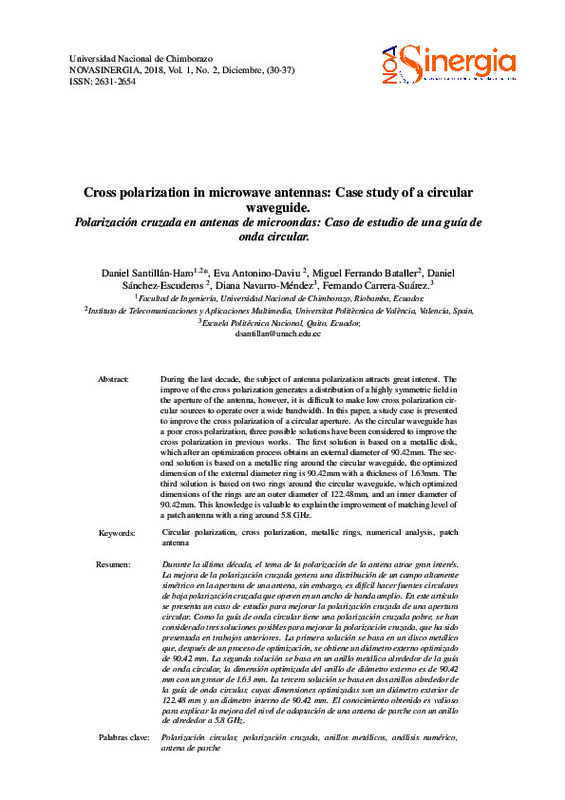JavaScript is disabled for your browser. Some features of this site may not work without it.
Buscar en RiuNet
Listar
Mi cuenta
Estadísticas
Ayuda RiuNet
Admin. UPV
Cross polarization in microwave antennas: Case study of a circular waveguide
Mostrar el registro sencillo del ítem
Ficheros en el ítem
| dc.contributor.author | Santillán-Haro, Daniel Antonio
|
es_ES |
| dc.contributor.author | Antonino Daviu, Eva
|
es_ES |
| dc.contributor.author | Ferrando Bataller, Miguel
|
es_ES |
| dc.contributor.author | Sánchez-Escuderos, Daniel
|
es_ES |
| dc.contributor.author | Navarro-Méndez, Diana Verónica
|
es_ES |
| dc.contributor.author | Carrera-Suárez, Luis Fernando
|
es_ES |
| dc.date.accessioned | 2019-05-22T20:28:30Z | |
| dc.date.available | 2019-05-22T20:28:30Z | |
| dc.date.issued | 2018 | es_ES |
| dc.identifier.uri | http://hdl.handle.net/10251/120926 | |
| dc.description.abstract | [ES] Durante la ultima d ¿ ecada, el tema de la polarizaci ¿ on de la antena atrae gran inter ¿ es. ¿ La mejora de la polarizacion cruzada genera una distribuci ¿ on de un campo altamente ¿ simetrico en la apertura de una antena, sin embargo, es dif ¿ ¿¿cil hacer fuentes circulares de baja polarizacion cruzada que operen en un ancho de banda amplio. En este art ¿ ¿¿culo se presenta un caso de estudio para mejorar la polarizacion cruzada de una apertura ¿ circular. Como la gu¿¿a de onda circular tiene una polarizacion cruzada pobre, se han ¿ considerado tres soluciones posibles para mejorar la polarizacion cruzada, que ha sido ¿ presentada en trabajos anteriores. La primera solucion se basa en un disco met ¿ alico ¿ que, despues de un proceso de optimizaci ¿ on, se obtiene un di ¿ ametro externo optimizado ¿ de 90.42 mm. La segunda solucion se basa en un anillo met ¿ alico alrededor de la gu ¿ ¿¿a de onda circular, la dimension optimizada del anillo de di ¿ ametro externo es de 90.42 ¿ mm con un grosor de 1.63 mm. La tercera solucion se basa en dos anillos alrededor de ¿ la gu¿¿a de onda circular, cuyas dimensiones optimizadas son un diametro exterior de ¿ 122.48 mm y un diametro interno de 90.42 mm. El conocimiento obtenido es valioso ¿ para explicar la mejora del nivel de adaptacion de una antena de parche con un anillo ¿ de alrededor a 5.8 GHz | es_ES |
| dc.description.abstract | [EN] During the last decade, the subject of antenna polarization attracts great interest. The improve of the cross polarization generates a distribution of a highly symmetric field in the aperture of the antenna, however, it is difficult to make low cross polarization circular sources to operate over a wide bandwidth. In this paper, a study case is presented to improve the cross polarization of a circular aperture. As the circular waveguide has a poor cross polarization, three possible solutions have been considered to improve the cross polarization in previous works. The first solution is based on a metallic disk, which after an optimization process obtains an external diameter of 90.42mm. The second solution is based on a metallic ring around the circular waveguide, the optimized dimension of the external diameter ring is 90.42mm with a thickness of 1.63mm. The third solution is based on two rings around the circular waveguide, which optimized dimensions of the rings are an outer diameter of 122.48mm, and an inner diameter of 90.42mm. This knowledge is valuable to explain the improvement of matching level of a patch antenna with a ring around 5.8 GHz. | es_ES |
| dc.description.sponsorship | This work has been supported by the Spanish Ministry of Science, Innovation and Universities (Ministerio de Ciencia, Innovacion y Universidades) under ´ the projects TEC2016-79700-C2-1-R, TEC2016- 78028-C3-3-P and college scholarship graduate of the National University of Chimborazo. | |
| dc.language | Inglés | es_ES |
| dc.publisher | Universidad Nacional de Chimborazo | es_ES |
| dc.relation.ispartof | NOVASINERGIA | es_ES |
| dc.rights | Reconocimiento - No comercial - Sin obra derivada (by-nc-nd) | es_ES |
| dc.subject | Circular polarization | es_ES |
| dc.subject | Cross polarization | es_ES |
| dc.subject | Metallic rings | es_ES |
| dc.subject | Numerical analysis | es_ES |
| dc.subject | Patch antenna | es_ES |
| dc.subject.classification | TEORIA DE LA SEÑAL Y COMUNICACIONES | es_ES |
| dc.title | Cross polarization in microwave antennas: Case study of a circular waveguide | es_ES |
| dc.title.alternative | Polarización cruzada en antenas de microondas: Caso de estudio de una guía de onda circular | es_ES |
| dc.type | Artículo | es_ES |
| dc.relation.projectID | info:eu-repo/grantAgreement/MINECO//TEC2016-78028-C3-3-P/ES/DISEÑO DE ANTENAS MULTIHAZ DE ALTA GANANCIA PARA LOS SISTEMAS DE COMUNICACIONES DE NUEVA GENERACION/ | es_ES |
| dc.relation.projectID | info:eu-repo/grantAgreement/MINECO//TEC2016-79700-C2-1-R/ES/NUEVAS ANTENAS PARA COMUNICACIONES MOVILES POR SATELITE EN BANDA KA/ | es_ES |
| dc.rights.accessRights | Abierto | es_ES |
| dc.contributor.affiliation | Universitat Politècnica de València. Departamento de Comunicaciones - Departament de Comunicacions | es_ES |
| dc.contributor.affiliation | Universitat Politècnica de València. Instituto Universitario de Telecomunicación y Aplicaciones Multimedia - Institut Universitari de Telecomunicacions i Aplicacions Multimèdia | es_ES |
| dc.description.bibliographicCitation | Santillán-Haro, DA.; Antonino Daviu, E.; Ferrando Bataller, M.; Sánchez-Escuderos, D.; Navarro-Méndez, DV.; Carrera-Suárez, LF. (2018). Cross polarization in microwave antennas: Case study of a circular waveguide. NOVASINERGIA. 1(2):2631-2654. http://hdl.handle.net/10251/120926 | es_ES |
| dc.description.accrualMethod | S | es_ES |
| dc.relation.publisherversion | http://novasinergia.unach.edu.ec/index.php/novasinergia | es_ES |
| dc.description.upvformatpinicio | 2631 | es_ES |
| dc.description.upvformatpfin | 2654 | es_ES |
| dc.type.version | info:eu-repo/semantics/publishedVersion | es_ES |
| dc.description.volume | 1 | es_ES |
| dc.description.issue | 2 | es_ES |
| dc.identifier.eissn | 2631-2654 | es_ES |
| dc.relation.pasarela | S\374409 | es_ES |
| dc.contributor.funder | Ministerio de Economía y Competitividad | es_ES |






